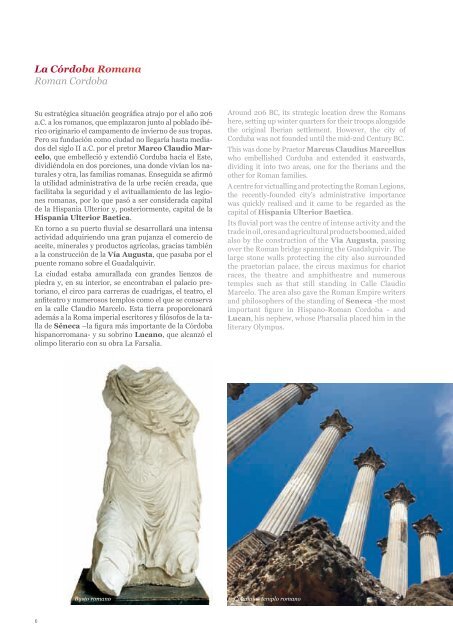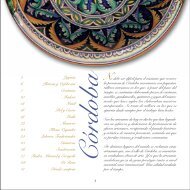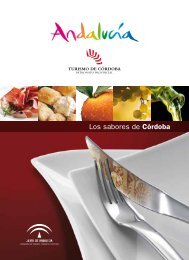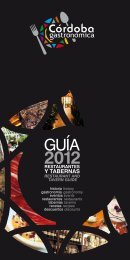Create successful ePaper yourself
Turn your PDF publications into a flip-book with our unique Google optimized e-Paper software.
La Córdoba Romana<br />
Roman Cordoba<br />
Su estratégica situación geográfica atrajo por el año 206<br />
a.C. a los romanos, que emplazaron junto al poblado ibérico<br />
originario el campamento de invierno de sus tropas.<br />
Pero su fundación como ciudad no llegaría hasta mediados<br />
del siglo II a.C. por el pretor Marco Claudio Marcelo,<br />
que embelleció y extendió Corduba hacia el Este,<br />
dividiéndola en dos porciones, una donde vivían los naturales<br />
y otra, las familias romanas. Enseguida se afirmó<br />
la utilidad administrativa de la urbe recién creada, que<br />
facilitaba la seguridad y el avituallamiento de las legiones<br />
romanas, por lo que pasó a ser considerada capital<br />
de la Hispania Ulterior y, posteriormente, capital de la<br />
Hispania Ulterior Baetica.<br />
En torno a su puerto fluvial se desarrollará una intensa<br />
actividad adquiriendo una gran pujanza el comercio de<br />
aceite, minerales y productos agrícolas, gracias también<br />
a la construcción de la Vía Augusta, que pasaba por el<br />
puente romano sobre el Guadalquivir.<br />
La ciudad estaba amurallada con grandes lienzos de<br />
piedra y, en su interior, se encontraban el palacio pretoriano,<br />
el circo para carreras de cuadrigas, el teatro, el<br />
anfiteatro y numerosos templos como el que se conserva<br />
en la calle Claudio Marcelo. Esta tierra proporcionará<br />
además a la Roma imperial escritores y filósofos de la talla<br />
de Séneca –la figura más importante de la Córdoba<br />
hispanorromana- y su sobrino Lucano, que alcanzó el<br />
olimpo literario con su obra La Farsalia.<br />
Around 206 BC, its strategic location drew the Romans<br />
here, setting up winter quarters for their troops alongside<br />
the original Iberian settlement. However, the city of<br />
Corduba was not founded until the mid-2nd Century BC.<br />
This was done by Praetor Marcus Claudius Marcellus<br />
who embellished Corduba and extended it eastwards,<br />
dividing it into two areas, one for the Iberians and the<br />
other for Roman families.<br />
A centre for victualling and protecting the Roman Legions,<br />
the recently-founded city’s administrative importance<br />
was quickly realised and it came to be regarded as the<br />
capital of Hispania Ulterior Baetica.<br />
Its fluvial port was the centre of intense activity and the<br />
trade in oil, ores and agricultural products boomed, aided<br />
also by the construction of the Via Augusta, passing<br />
over the Roman bridge spanning the Guadalquivir. The<br />
large stone walls protecting the city also surrounded<br />
the praetorian palace, the circus maximus for chariot<br />
races, the theatre and amphitheatre and numerous<br />
temples such as that still standing in Calle Claudio<br />
Marcelo. The area also gave the Roman Empire writers<br />
and philosophers of the standing of Seneca -the most<br />
important figure in Hispano-Roman Cordoba - and<br />
Lucan, his nephew, whose Pharsalia placed him in the<br />
literary Olympus.<br />
Busto romano<br />
Columnas templo romano<br />
6







